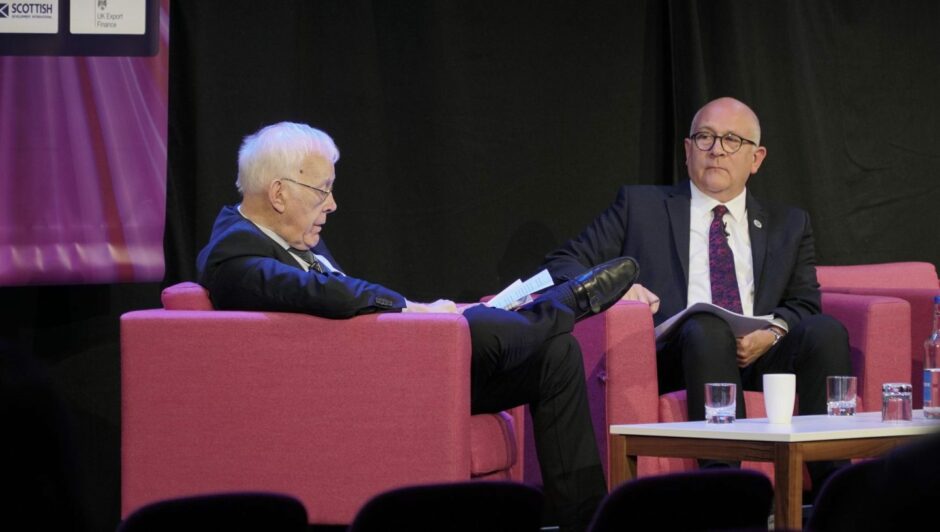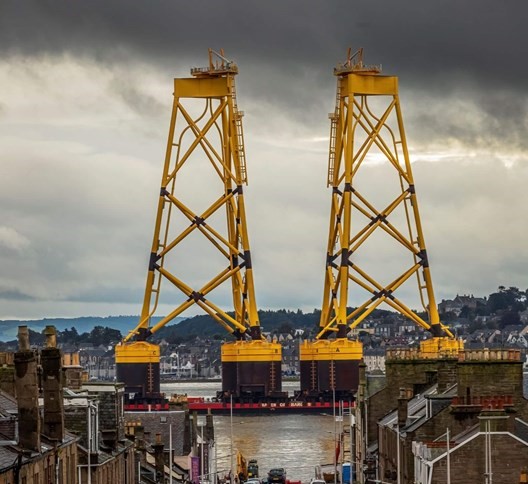
Sir Ian Wood has said it is unlikely that the UK supply chain will take more than 20% of the major fabrication work in the early wave of ScotWind contracts.
Speaking at the Energy Exports Conference in Aberdeen, the former oil tycoon was asked about the chances of UK suppliers winning the swathe of offshore wind work ahead, or lose out to international firms due to publicly tendered work and capacity constraints.
In reply, he said the north-east of Scotland has “taken a bit of time” to shift from oil and gas and get significantly involved in the new offshore wind industry.
“I think there’s now a major effort to catch up.
“In the early days, a lot of the major fabrication infrastructure in the ScotWind round…I can’t believe we’ll be ready to do more than perhaps take 10, 15, 20% of the heavy stuff that’s going to be involved.
“But we absolutely need to speed up as quickly as we possibly can. There’s a gap.
“Fortunately, we’re not going to need the really significant contracts to be manned up (until) probably about 2024, 2025. So we’ve got a little bit of time but we’re going to have to work really hard to get on top of that.”
ScotWind represents a total of 17 huge offshore wind projects in Scottish waters, with multibillion-pound investments.
Sir Ian spoke about issues raised by the Scottish Offshore Wind Energy Council last year about the need to ramp up capability in the supply chain and improve capacity in Scotland’s ports at pace.
Several of Scotland’s major wind projects, like Seagreen off Angus, have had the majority of their major fabrication work take place overseas.
The supply chain has also recently seen major floating and fixed wind contracts for Scottish projects go to the UAE and China.
It comes as contracts will be awarded in coming years for the ScotWind projects, which saw seabed space awarded for 25GW of capacity with an estimated Scottish spending commitment of more than £25bn.
Freeport status being allocated to the north-east and the Cromarty Firth will be “extremely important” in finding success, Sir Ian said.
The businessman, chairman of Aberdeen’s Energy Transition Zone (ETZ) in the south of Aberdeen and economic development body Opportunity North East (ONE), pointed to several initiatives underway with the ETZ including a floating wind innovation centre and a green hydrogen test and demonstration facility.
“We’re also looking at possible high-value manufacturing. There’s cables, electrolysers and so on, quite high-tech ones so that’s going to be very important.
“There will be, I think, a gap over the next two or three years. Hopefully we won’t lose out too much in the beginning.”
The ETZ is planning a supply chain summit in August, attended by First Minister Nicola Sturgeon and energy minister Michael Matheson, with the key focus on maximising and accelerating supply chain involvement.
During the interview, with Energy Industries Council CEO Stuart Broadley, Sir Ian also highlighted the “real danger of bureaucratic delays” around planning and issues around grid connections, which could ultimately be a barrier to net zero.
“Failure to significantly enhance our supply chain capability will undoubtedly damage our economy. Energy is extremely important, particularly in Scotland but in the UK, and we absolutely must take full advantage of this opportunity.”
Earlier, on the opening panel of the conference, Aker Offshore Winds UK managing director Sian Lloyd Rees touched on the domestic market opportunity for Britain’s supply chain.
She said: “We’re never going to be the cheapest wind or hydrogen developer in the world. When it comes to scale, there’ll be others. But there are niche areas where moving fast and satisfying the domestic requirement means we can grow the capabilities we need to underpin that in the UK here and then use it for our future export capabilities.
“I leave with one message: the opportunity is here for supply chain companies embedded in the UK to not only support the domestic market but also to grow globally. From a development perspective, the UK is a very attractive for us to be in for the fiscal stability and a number of early actions that have been taken.
“But I think for me the timing is right now if we want to really capture this.”
Recommended for you


 © SSE Renewables/ Ken le Grice
© SSE Renewables/ Ken le Grice